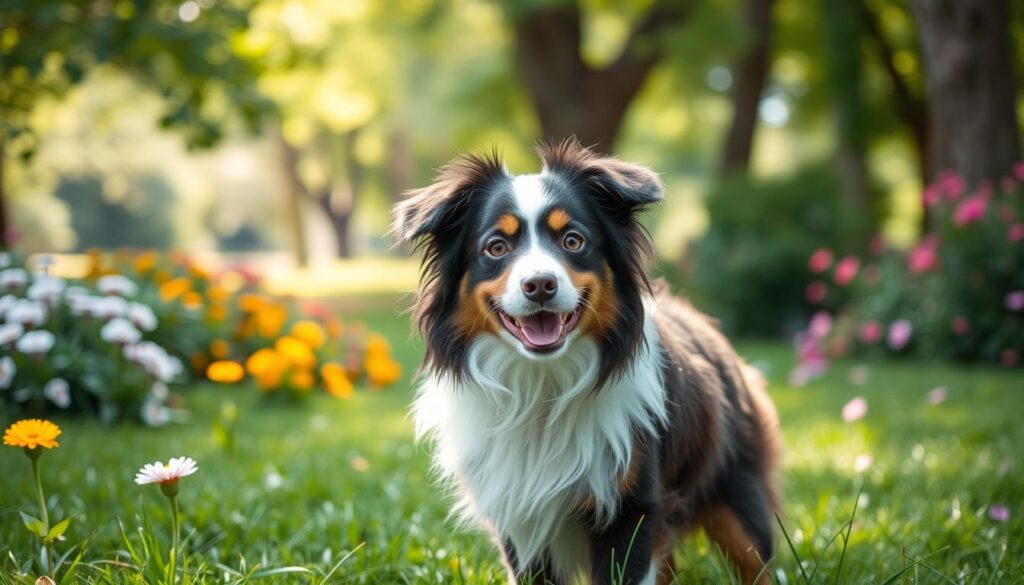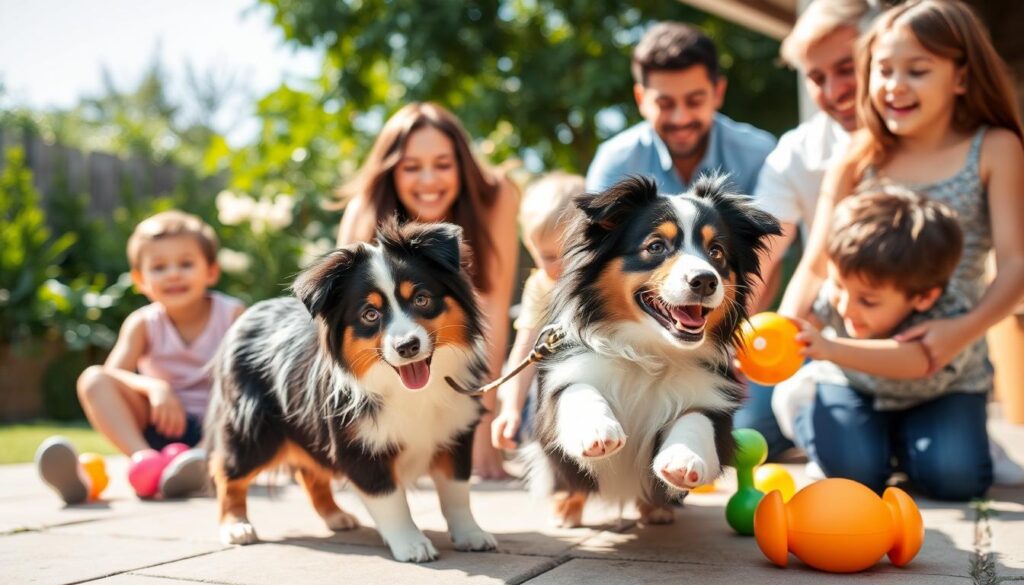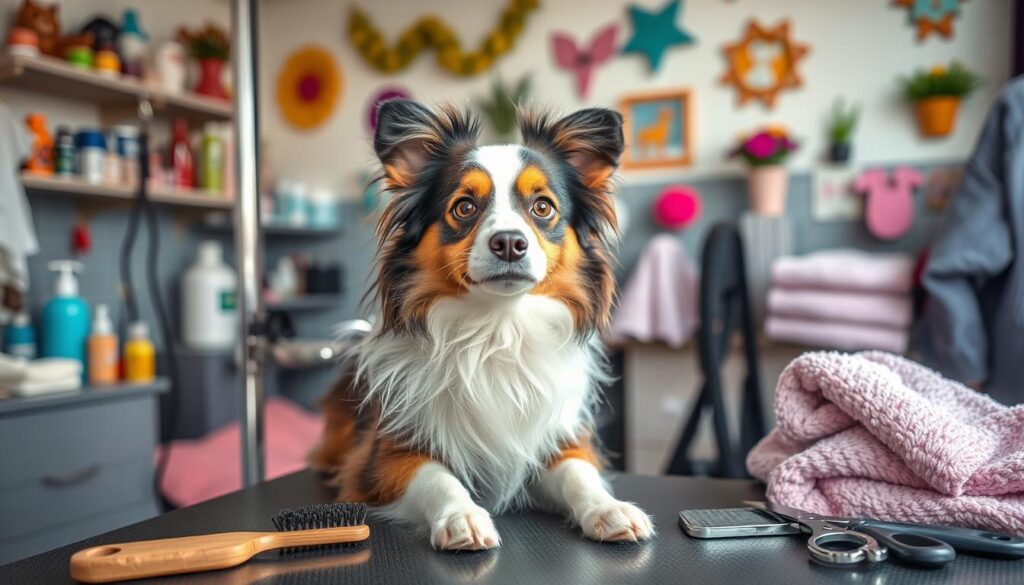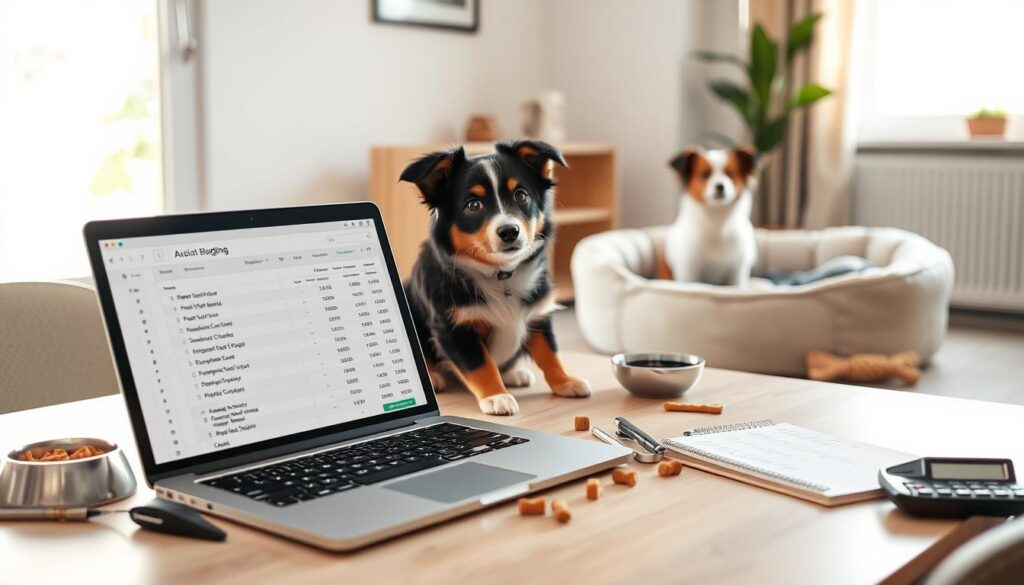The Adult Miniature Australian Shepherd is very smart and loves to please. It’s full of energy and makes a great family pet or working dog. I’ll talk about how to care for my Miniature Australian Shepherd. This includes its history, traits, exercise needs, training, grooming, and health issues.
Key Takeaways
- The Adult Miniature Australian Shepherd stands between 14 to 18 inches tall, weighing 20 to 40 pounds.
- This breed has a life expectancy of around 12 to 15 years.
- Daily exercise requirements include a minimum of 30-60 minutes for optimal health.
- Common health issues may involve hip and elbow dysplasia, epilepsy, and sensitivity to certain medications.
- I can expect to spend between $800 to $1,500 when acquiring a Miniature Australian Shepherd.
Introduction to the Miniature Australian Shepherd
The Miniature Australian Shepherd is a lively and compact friend. They are perfect for people and families. They are small but full of energy and love to play.
These dogs are smart and love to be active. They need lots of time with people to be happy. They live for about 12 to 16 years.

Knowing what makes them special is key. It helps you care for and train them well. This way, you and your dog can have a great time together.
Breed History of Miniature Australian Shepherds
The miniature australian shepherd history is rich and deep. It started in the Basque region, between Spain and France. These dogs were great at helping shepherds with their sheep.
In the late 1960s, California breeders wanted smaller Australian Shepherds. They bred them to make the Miniature Australian Shepherd. This breed became popular for being loving and good at many tasks.
In 1989, the Miniature Australian Shepherd was officially recognized. By 1990, the Miniature Australian Shepherd Club of the USA (MASCUSA) was formed. They worked to get the breed recognized.
By 1993, the American Kennel Club (AKC) recognized the Australian Shepherd. This was a big step. The breed’s name was changed in 1998 by ARBA. In 2011, the AKC named it the Miniature American Shepherd.
By July 1, 2015, it was fully recognized by the AKC. It’s part of the Herding Group. The Miniature American Shepherd is now very popular, especially in the early 1990s.

| Year | Event |
|---|---|
| 1980 | First registration with the National Stock Dog Registry based on height. |
| 1989-1990 | Formal recognition of the Miniature Australian Shepherd. |
| 1990 | MASCUSA formed to support the breed. |
| 1993 | Miniature Australian Shepherds showed alongside Australian Shepherds. |
| 1998 | ARBA changed breed name policy, reintroducing “Miniature Australian Shepherd.” |
| 2011 | AKC accepted Miniature American Shepherds under MASCUSA. |
| 2015 | Fully recognized as an AKC Herding Breed. |
Adult Miniature Australian Shepherd Characteristics
The adult miniature Australian shepherd is a special breed. They are small, look great, and have a unique personality. Knowing about this breed helps us see why they are such great friends.
Size and Weight of Adult Miniature Australian Shepherds
These dogs are usually 14 to 18 inches tall. Males and females weigh 20 to 40 pounds. They fit well in small places or big homes with yards.
Their size is just right, making them look balanced and quick.
Coat Colors and Patterns
Their coat is a big part of their charm. They come in many colors and patterns. These include:
- Black
- Blue Merle
- Red
- Red Merle
They also have white markings and copper points. These add to their beauty and uniqueness.
Personality Traits and Temperament
These dogs are smart, full of energy, and very loyal. They love to be around people. They can herd, but might nip if not socialized right.
They are alert and make great watchdogs. Their love for family is strong.

Do Miniature Australian Shepherds Shed a Lot?
Thinking about a miniature australian shepherd makes me think about shedding. They have a thick double coat that needs regular grooming. Shed hairs pile up all year, but they shed more in the seasons.
Brushing them regularly, like a couple of times a week, keeps their coat shiny. Even though they have a double coat, miniature australian shepherds don’t shed as much as big dogs. Their soft coat is easy to pet without getting hair on your hands.
When grooming, I watch for dreads behind the ears or around the butt. Trimming them is easy. Remember, grooming is just part of keeping them happy and healthy. They also need exercise and mental games.

Are Miniature Australian Shepherds Good Family Dogs?
Miniature Australian Shepherds are great family dogs. They have a playful spirit that kids love. This makes them a big part of the family.
These dogs are also very protective. They make good watchdogs. But, they need to be socialized early to be friendly with everyone.
They are easy to adapt to any home. They fit well in big or small houses. Their size and energy make them easy to include in family activities.

With the right care, Miniature Australian Shepherds become wonderful family pets. They offer love, protection, and energy to make life better.
Exercise Requirements for the Miniature Australian Shepherd
It’s important to know how much exercise a miniature australian shepherd needs. They need at least one hour of hard play every day. This keeps them fit and happy.
Adding different activities to their day is key. It keeps them physically fit and mentally sharp. This stops them from getting bored.
Daily Exercise Routines
Having a set routine is important for my dog. Daily activities can include:
- Long walks or brisk runs
- Intense play sessions with a frisbee or ball
- Training exercises that challenge their intelligence
- Socialization outings with other dogs
These activities help them behave well. They also make sure they get enough exercise. Miniature australian shepherds love to play and be around people.
Indoor and Outdoor Activities
Outdoor play is important, but indoor games are too. Indoor games keep their minds sharp and stop them from getting into trouble. Here are some fun indoor games:
- Puzzle toys that require problem-solving
- Hide and seek games, enhancing their tracking abilities
- Interactive training sessions focusing on new tricks
By mixing outdoor play with indoor games, my dog stays healthy and happy. Keeping them active is key to their happiness and long life.

Nutrition and Diet Tips for Adult Miniature Australian Shepherds
Proper nutrition is key for my Miniature Australian Shepherd’s health and energy. A balanced diet keeps them well and prevents health problems. I choose high-quality dog food with the right proteins, fats, and carbs.
Proteins are important for growth and health in a miniature australian shepherd. Whole meats give the amino acids needed for muscles and repair. I avoid byproducts and meat meals for the best nutrition. For example, The Honest Kitchen has Grain-Free Beef Clusters with 26% protein and 14.5% fat.
Fats are also crucial in my dog’s diet. They give more calories than proteins or carbs. Healthy fats help with energy, vitamin absorption, and brain function. Foods with omega fatty acids make their skin and coat shiny.
Carbs give energy, but I pick high-quality sources to avoid digestive problems. I avoid wheat or corn to keep my dog comfortable. The right diet tips keep their digestive system happy.
For hydration, I use The Honest Kitchen’s Bone Broth Pour Overs. They add moisture and some protein and fats to meals. These choices help keep my Miniature Australian Shepherd’s energy up and supports their active life.

Best Adult Miniature Australian Shepherd Breeders
Finding the right Miniature Australian Shepherd can be exciting. Working with top breeders means your dog gets the best care. They focus on health and quality.
These breeders have over 15 years of experience. They pick adult dogs with great temperaments and skills. They also do health checks before breeding.
Mini Australian Shepherds are 14 to 18 inches tall and weigh 15 to 40 pounds. Breeders have older puppies and young adults for adoption. Prices range from $400 to $850, depending on the dog’s traits and if it can be bred.
These puppies are often litter box trained. This makes potty training outside easier. They are registered with groups like ASDR and AKC, showing their quality.

Breeders suggest TLC Pet Food for its healthy ingredients. They offer free delivery in Canada and the U.S. They also give discounts and free gifts on first orders.
Many families love their Mini Aussies for their smarts, agility, and love. If you want an adult Miniature Australian Shepherd, many are available. They are 2 to 5 years old and have different sizes and eye colors.
These dogs are crate trained and know how to use doggie doors. Some have been trained for breeding. They are up to date on shots and prevent fleas and heartworms.
For more information, breeders give their contact details. Families should think about the options, like spay contracts and whether to breed the dog.
| Characteristic | Details |
|---|---|
| Size Range | 14 – 18 inches tall |
| Weight Range | 15 – 40 lbs |
| Age of Available Adults | 2 to 5 years old |
| Price Range | $400 – $850 |
| Training Status | Crate trained, house trained, and leash trained |
| Health Status | Up to date on shots, worming, flea prevention |
Grooming Tips for Your Miniature Australian Shepherd
My Miniature Australian Shepherd needs regular grooming. This keeps their coat healthy and clean. A good grooming routine makes them look great and feel good too.
Brushing and Bathing Schedule
I brush my dog once a week. This keeps their coat smooth and reduces shedding. In spring and fall, I brush more often to handle extra fur.
I bathe them every 4 to 6 weeks. If they get really dirty, I bathe them more often. It’s key to use gentle bath products to keep their skin moist.
Dental Care and Ear Cleaning
Dental care is vital for my dog’s health. I brush their teeth a few times a week to stop dental problems. Cleaning their ears every two weeks with a safe solution helps avoid infections.
Having a grooming routine for dental care and ear cleaning boosts my dog’s health and happiness.

| Grooming Task | Recommended Frequency | Notes |
|---|---|---|
| Brushing | At least once a week | More often during shedding seasons |
| Bathing | Every 4-6 weeks | Frequency may increase if dirty |
| Dental Care | 2-3 times per week | Prevents periodontal disease |
| Ear Cleaning | Bi-weekly | Avoids ear infections |
| Nail Trimming | As needed | Prevent overgrowth and related issues |
Training Your Adult Miniature Australian Shepherd
Training a miniature australian shepherd is fun for both the dog and the owner. They are smart and love to please. This makes training easy with the right techniques.
Basic Training Techniques
Start with basic commands early on. Teach them to sit, down, recall, and walk on a leash. Short training sessions keep them focused and help them remember.
Use treats or praise to reward them. This makes them happy and eager to learn. It’s important to use the same words every time to avoid confusion.
As they get better, they can learn more. By six months, they can even learn to use a crate. They might even enjoy agility and obedience training.
Importance of Socialization
Socialization is key for a well-adjusted miniature australian shepherd. Introduce them to new places, people, and dogs from 7 weeks to 4 months. This helps them feel confident and avoids bad behavior.
By one year, they should be okay alone and know basic commands. Socialization is crucial for a strong bond with your pet.

Common Health Issues in Miniature Australian Shepherds
I love my miniature australian shepherd and know they can get sick. They are mostly healthy but can face health risks. Taking them to the vet often is key to catching problems early.
Regular Vet Check-ups
It’s important to take my miniature australian shepherd to the vet often. These visits help find health issues early. Some common problems include:
- Hip dysplasia, which affects about 10% of miniature australian shepherds.
- Eye problems like Progressive Retinal Atrophy (PRA) and hereditary cataracts.
- Dental diseases, which can cause big problems if not treated.
- Obesity, a big risk that can cause joint and heart problems.
- Infections and parasites, like fleas and ticks, are common in this breed.
Understanding Health Risks
Knowing about health risks helps me keep my miniature australian shepherd safe. Some big risks are:
| Health Risk | Description | Prevalence |
|---|---|---|
| Hip Dysplasia | A painful condition that may lead to arthritis. | 10% of the breed |
| PRA | Progressive Retinal Atrophy leading to blindness. | Common in adults up to 9 years |
| Multidrug Resistance | A genetic defect affecting medication processing. | 40% carry the mutation |
| Dental Disease | Common in pets, potentially leading to serious problems. | 12% display serious dental issues |
| Obesity | Significant risk leading to joint and heart problems. | Common in many dogs |

Understanding Miniature Australian Shepherd Behavior
Miniature Australian Shepherds show many interesting behaviors. They are very smart and have strong herding instincts. This means they might chase and nip things. It’s important to train them well to keep them happy and safe.
These dogs are great at solving problems. They learn commands fast and love to play. They need fun games and activities to keep them busy and happy.

Mini Aussies have a strong prey drive and need to be socialized well. They love to be near their people, staying 20-50 feet away. They are very affectionate and might lick your face. But, they can get too focused when they’re tired.
It’s up to the owners to guide them well. Setting clear rules and training them consistently is key. Fun activities like puzzle toys and agility courses keep them balanced. Understanding their behavior leads to a great bond with this lively breed.
Budgeting for Your Adult Miniature Australian Shepherd
Getting a Miniature Australian Shepherd is a big deal. It means thinking about adoption costs and what it costs to keep them happy and healthy. Having a good budget helps make sure they get the care they need.
Initial Costs of Adoption
The cost of getting a Miniature Australian Shepherd can change a lot. You might pay for:
- Adoption fee, which can be $100 to $500
- Vaccines, costing $100 to $300
- Spaying or neutering, which is $200 to $500
- Stuff like collars, leashes, and beds for $50 to $150
These costs add up to make sure you’re ready for your new pet.
Daily and Yearly Expenses
After adopting, you’ll have to think about daily costs and yearly expenses. Here’s what you might spend:
| Expense Category | Monthly Cost | Yearly Cost |
|---|---|---|
| Food | $40 – $70 | $480 – $840 |
| Treats | $15 – $30 | $180 – $360 |
| Veterinary Care | $50 – $100 | $600 – $1,200 |
| Grooming | $20 – $40 | $240 – $480 |
| Toys and Entertainment | $20 – $40 | $240 – $480 |
| Training | $50 – $150 | $600 – $1,800 |
| Emergency Fund (Monthly Savings) | $50 – $100 | $600 – $1,200 |
These costs add up over the year. Saving for emergencies and training is key to caring for your Miniature Australian Shepherd.

Adopting an Adult Miniature Australian Shepherd
Adopting an adult miniature Australian shepherd is exciting but can feel overwhelming. I started by researching rescue groups for this breed. Aussie Rescue So Cal Inc. is one such group, helping dogs in Southern California find homes.

The adoption process starts with an application. You’ll need to talk to the rescue, give references, and might have a home visit. A safe yard is important because these dogs are full of energy.
The dogs are ready to go, with shots, spayed or neutered, and microchipped. You can help by checking the rescue’s website for events. Buying items from their store also helps save more dogs.
| Step in Adoption Process | Description |
|---|---|
| Research Adoption Agencies | Find good groups like Aussie Rescue So Cal Inc. for Australian shepherds. |
| Application Submission | Fill out an application with your info and references. |
| Interviews and References | Do interviews and have references checked to see if you’re a good fit. |
| Home Visit | A visit to your home to make sure it’s safe for the dog. |
| Adoption Fee | Pay any fees, which cover shots and spay/neuter. |
| Transportation Arrangements | The rescue might help with getting the dog to your home. |
Getting an adult miniature Australian shepherd is a big deal. It’s about finding the right match for both you and the dog. Rescuers are key in bringing dogs and people together. I’m committed to giving a loving home to one of these amazing dogs.
Top Adult Miniature Australian Shepherd Stud Dogs
Finding the best stud dogs among adult miniature Australian shepherds takes hard work and careful research. It’s key to choose a reputable breeding program. This ensures healthy puppies with the traits you want.
Looking at health clearances from trusted breeders is very important. It shows the genetic history and health of the stud dogs.
Many breeders join groups like the Miniature American Shepherd Club of the USA. This means they follow health testing rules. The program I trust does regular checks. This makes me sure of their quality.

- Health Testing: This shows if there are hereditary health problems.
- Strengths in Breed Standards: Each stud should meet the breed’s ideal look and behavior.
- Lineage: A good bloodline means the stud might pass on great traits to puppies.
- Training Background: Stud dogs that have been in training are more likely to have puppies with good behavior.
By looking at these things, I can find breeders who care about healthy and happy puppies. Puppies from quality stud dogs can be great in competitions or as loving pets. It’s important to learn about breeding practices to keep these wonderful traits alive.
Conclusion
Caring for an adult miniature Australian Shepherd is very rewarding. They need exercise, training, grooming, and health care. These dogs are small, lively, and very smart.
They are usually 13-18 inches tall and weigh 20-40 pounds. My Mini Aussie needs to run and play to stay happy. They also need to think and learn new things.
Going to the vet often is important. This helps catch health problems early, like hip dysplasia and cataracts. I make sure they eat well and get regular grooming.
Weekly brushing and nail trimming keep them healthy. Knowing how to care for them makes our life together fun and exciting.
The bond we share is very special. It brings us lots of joy. Taking care of my Mini Aussie is a big responsibility, but it’s worth it.
By meeting their needs, they can live a happy life. This makes our time together even more loving and fun.
